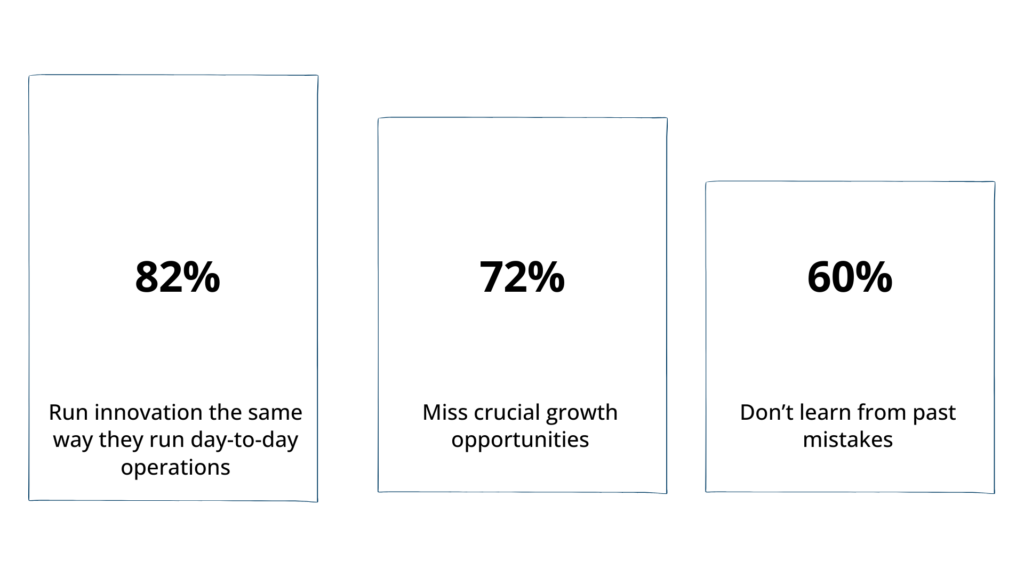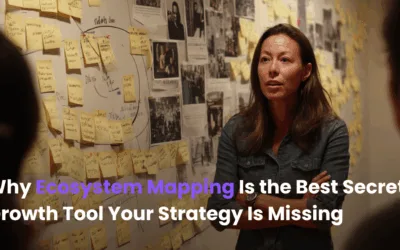Innovation drives business growth and keeps companies competitive. An essential component to this growth is the entrepreneur mindset and the culture of the organisation as it tackles innovation of all kinds.
Key takeaways
- Innovation is crucial for growth and survival in business, especially during economic disruptions, requiring an entrepreneur mindset open to experimentation and adaptation.
- Different types of innovation—sustaining, disruptive, architectural, and technological—offer diverse strategies for businesses to enhance their market presence and address customer needs.
- Overcoming challenges to innovation, such as resistance to change and limited resources, requires effective leadership, strategic resource allocation, and fostering a culture of collaboration.
Understanding innovation and the entrepreneur mindset
Imagine walking into a workspace where every individual is brimming with the fervour to innovate, to question the status quo, and to take ownership of not just their roles but the overall vision of the company. This isn’t a utopian dream; it’s the power of fostering an entrepreneurial mindset within an organization.
Carol Dweck’s concept of a growth mindset has been a game-changer, showing us the value of embracing challenges, persisting in the face of setbacks, and seeing effort as a pathway to mastery. But why restrict this mindset to personal development or startups when it can be a catalyst for transformation within established companies?
Often, the term ‘entrepreneurial mindset’ conjures images of a lone visionary, a startup founder working tirelessly to bring an idea to life. However, the essence of this mindset—innovation, flexibility, and a relentless pursuit of improvement—isn’t exclusive to founders or new businesses. It’s a potent tool for companies of all sizes that want to stay ahead of the curve and appeal to the emerging workforce, particularly Gen Z.
So, why is it essential for organisations to cultivate this entrepreneurial mindset among their employees? Let’s dive in.
First off, the business landscape is changing at a breakneck pace. Advances in technology, evolving consumer behaviours, and global interconnectedness mean that organisations must be agile to survive and thrive. An entrepreneurial mindset empowers employees to be proactive, anticipate changes, and adapt quickly. When your team is equipped to pivot without awaiting directives, your organisation becomes more resilient and innovative.
Moreover, today’s young professionals, especially Gen Z, are not just looking for a job. They are seeking purpose, autonomy, and personal growth. They’re switching from the traditional career ladder to a career lattice, where acquiring diverse experiences and skills is the priority. By promoting entrepreneurial thinking, you offer these bright minds a platform to experiment, learn, and grow—which, in turn, strengthens your talent pool and enhances your attractiveness as an employer.
But how can an organisation instill an entrepreneurial mindset? Here are a few strategies:
Encourage Ownership and Accountability Make it clear that every team member’s input is valuable and that they have the autonomy to take charge of projects. Ownership breeds responsibility, which fosters a sense of pride in one’s work and a drive to achieve the best possible outcomes.
Foster a Culture of Continuous Learning Create an environment where learning is ongoing and failure is not frowned upon, but seen as a growth opportunity. Support cross-functional training, encourage attendance at workshops and seminars, and provide resources for professional development. When employees are learning, they’re evolving, and so is your organisation.
Promote Collaboration and Diverse Thinking Diversity isn’t just about ticking boxes; it’s about bringing together varied perspectives that breed innovation. Encourage teams to work across departments, share knowledge, and challenge each other’s ideas constructively. This approach can unlock creative solutions to complex problems.
Recognize and Reward Initiative Nothing fuels motivation quite like recognition. Acknowledge and reward employees who go the extra mile, challenge conventional thinking, or bring new ideas to the table. This not only boosts morale but also reinforces the behaviour you want to see throughout the organisation.
Offer Flexibility The entrepreneurial spirit thrives in flexible environments. Give employees the freedom to manage their time and work in ways that best suit their productivity. This trust conveys confidence in their abilities and encourages them to deliver their best work.
But let’s not forget that an entrepreneurial mindset is not a switch that’s flipped overnight. It’s a cultural shift that requires commitment from the top down. Leaders must lead by example, demonstrating a readiness to take risks, learn, and adapt. When leadership embodies the entrepreneurial spirit, it permeates throughout the organisation. Let’s look at the types of innovation so you have alignment between your people and the products they’re creating.
Types of Innovation
Innovation can be broadly categorized into four types:
- Sustaining Innovation
- Disruptive Innovation
- Architectural Innovation
- Technological Innovation
Understanding these types of innovation is crucial for entrepreneurs looking to harness their potential.
Sustaining innovation focuses on improving existing products or services to better meet customer demands. It is about incremental enhancements that keep the business competitive by continuously refining its offerings. On the other hand, disruptive innovation creates entirely new markets by offering simpler, more affordable alternatives. This type of innovation has the power to displace established industry leaders, demonstrating its profound impact on business dynamics.
Architectural innovation involves reconfiguring existing systems and technologies to create new products or services. It often combines existing components in novel ways, resulting in innovative solutions that can redefine market standards. Technological innovation, meanwhile, leverages high tech technologies to develop new products or processes, pushing the boundaries of what is possible and driving significant advancements in the industry.
A growth mindset is essential in fostering these types of innovation. It encourages entrepreneurs to view challenges as opportunities for learning and growth, thereby creating an environment where innovative ideas can thrive. Embracing a mindset that values creativity and experimentation enables businesses to continuously generate and implement innovative solutions that drive success.
The Role of Innovation in Business Growth
Innovation is a critical driver of business growth, enabling companies to maintain a competitive edge and adapt to the ever-changing market landscape. A conscious and purposeful search for opportunities allows most innovations to arise, keeping businesses ahead of the curve and meeting the evolving needs of their customers.
The impact of innovation extends beyond individual companies to the broader economy. It drives economic growth by creating new industries and job opportunities, fostering a dynamic and thriving business environment. As new technologies and business models emerge, they pave the way for increased productivity and economic development, benefiting society as a whole.
A key aspect of successful innovation lies in understanding and addressing user needs. Focusing on empathy and understanding user challenges allows entrepreneurs to develop solutions that resonate with the market. This user-centric approach increases the likelihood of market acceptance and long-term success for innovations.
Creating a culture that values idea generation and creative thinking is crucial for fostering innovation. When employees feel encouraged to share their ideas and experiment with new concepts, it leads to increased engagement and a higher likelihood of breakthrough innovations. This culture of innovation not only drives business growth but also enhances employee satisfaction and retention.
Overcoming Challenges in Innovation
Despite its many benefits, the path to innovation is fraught with challenges. Resistance to change is a common obstacle that can impede the innovation process. Organisations often encounter pushback from employees or stakeholders who are hesitant to embrace new ways of thinking and working. Overcoming this resistance requires effective change management strategies and clear communication about the benefits of innovation.
Limited resources and funding are also significant barriers to innovation. Many businesses struggle to allocate the necessary capital and resources to develop and implement innovative ideas. To address this, entrepreneurs must be strategic in their resource allocation and seek out alternative funding sources, such as grants, partnerships, or venture capital.
Leadership plays a crucial role in driving innovation. Innovators must set a clear agenda and vision for growth, attracting talent and fostering a collaborative environment that supports creative problem-solving. By championing innovation from the top, leaders can inspire and motivate their teams to embrace new ideas and approaches. In fact, an Accenture study suggests this is essential, with 60% of executives and managers indicating that they do not learn from past mistakes – and 82%run innovation the same way they do regular operations.

In addition, fostering a culture of collaboration and open communication is essential for overcoming challenges in innovation. Encouraging cross-functional teams to work together and share their diverse perspectives can lead to more effective problem-solving and innovative solutions. Addressing these challenges head-on enables businesses to create an environment where innovation thrives and drives long-term success.
The benefits of developing an entrepreneurial mindset are clear: increased agility, a culture of innovation, and an engaged workforce ready to rise to the challenges of a rapidly changing world. It’s not just about profit margins and market share—it’s about creating an environment where people are excited to contribute, grow, and ultimately, help the organisation achieve its most ambitious goals.
Frequently Asked Questions
What is the meaning of innovation?
Innovation to the process of redefining problems and creating new value. Ideally, an innovation resonates emotionally with people and solves an intractable problem.
What is the primary activity that encompasses entrepreneurship?
Innovation is the primary activity that encompasses entrepreneurship, driving the development of new ideas and solutions. This focus on innovation enables entrepreneurs to create value and differentiate themselves in the market.
How does innovation help during uncertain economic times?
Innovation drives cost savings and improves product and service offerings, enabling businesses to thrive during uncertain economic times. Emphasising creativity and adaptability is crucial for sustaining success.
What are the different types of innovation?
There are four primary types of innovation: sustaining, disruptive, architectural, and technological. Understanding these types can enhance your approach to fostering innovation effectively.
Why is innovation important for business growth?
Innovation is essential for business growth as it enhances competitiveness and drives economic expansion by creating new industries and job opportunities. Embracing innovation fosters a culture of creativity that can significantly contribute to sustained success.



